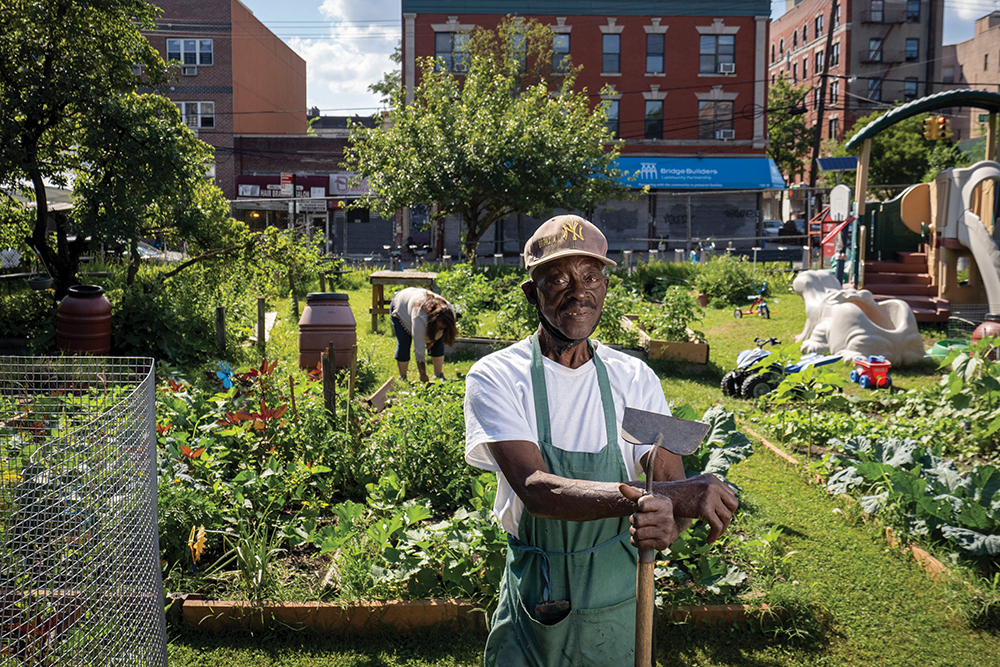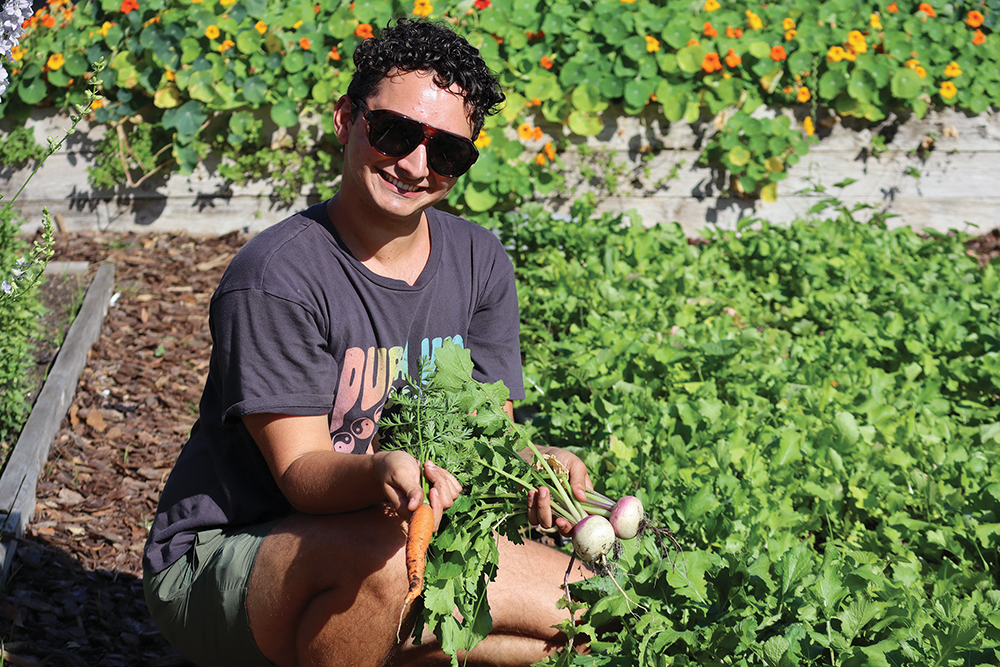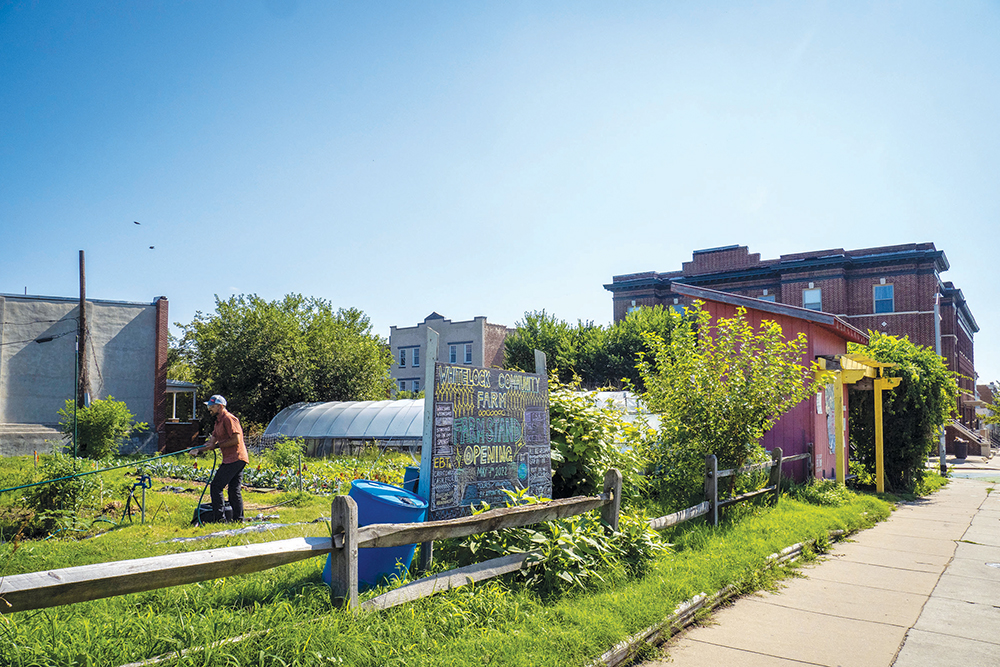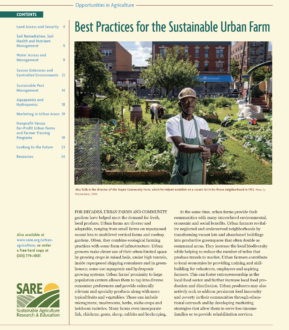
For decades, urban farms and community gardens have helped meet the demand for fresh, local produce. Urban farms are diverse and adaptable, ranging from small farms on repurposed vacant lots to multilevel vertical farms and rooftop gardens. Often, they combine ecological farming practices with some form of infrastructure. Urban growers make clever use of their often-limited space by growing crops in raised beds, under high tunnels, inside repurposed shipping containers and in greenhouses; some use aquaponic and hydroponic growing systems. Urban farms’ proximity to large population centers allows them to tap into diverse consumer preferences and provide culturally relevant and specialty products along with more typical fruits and vegetables. These can include microgreens, mushrooms, herbs, niche crops and heirloom varieties. Many farms even incorporate fish, chickens, goats, sheep, rabbits and beekeeping.
At the same time, urban farms provide their communities with many interrelated environmental, economic and social benefits. Urban farmers revitalize neglected and underserved neighborhoods by transforming vacant lots and abandoned buildings into productive greenspaces that often double as communal areas. They increase the local biodiversity while helping to reduce the number of miles that produce travels to market. Urban farmers contribute to local economies by providing training and skill-building for volunteers, employees and aspiring farmers. This can foster entrepreneurship in the local food sector and further increase local food production and distribution. Urban producers may also actively seek to address persistent food insecurity and poverty in their communities through educational outreach and by developing marketing strategies that allow them to serve low-income families or to provide rehabilitation services.

Researchers from Cornell University conducted a nationwide survey of successful commercial urban farms and described some of their common characteristics, including:
- Produce sales are usually not their sole source of revenue. Urban farms typically succeed by diversifying their income streams through activities such as agritourism, public workshops, farmer training or private events. Collaborations with other farms and local businesses are helpful to expand the products and services you can offer your community and clients.
- Urban farmers build meaningful relationships with customers and local businesses. This can help create a sense of community and invites the residents to get to know you and your farm’s values.
- They define and stick to a clear focus when starting out, then gradually explore others. It’s difficult for a new farm to be many things at once.
In recognition of the restorative role that urban farming can play in communities, city residents and their elected leaders are increasingly advocating for policies that support urban food production. Cities across the United States, from Cleveland to Kansas City to Baton Rouge, are supporting urban agriculture through legislative and policy changes. Policy reform can come in many ways, such as tax credits, improvements to land access or changes to zoning laws that currently restrict urban farming. At the federal level, the USDA has expanded funding in support of local and regional food systems through grants and cost-sharing programs for urban and peri-urban farms. See the Resources section.
This bulletin provides an overview of the important issues to consider as you establish and manage your urban farm or community garden, and it suggests where to go for in-depth information. From accessing land and managing production challenges (including soil, water and pests) to marketing your farm products, we share some of the current best practices that urban producers use to develop successful operations, as well as additional resources at the end.
How Urban Farming is Defined
Urban farming refers to agricultural production in and around urban centers, while peri-urban farms are near urban centers. Although urban farms have not been formally defined as a distinct kind of operation, the USDA defines any farm as an entity that produces at least $1,000 of agricultural products each year. Urban zones are described as areas with a population of more than 50,0000 people. Taken together, urban agriculture describes crop-producing operations in densely populated urban areas. Urban agriculture includes both for-profit and nonprofit organizations that operate community gardens, farms and other programs. Farmers grow crops in urban areas in many creative ways; they often take advantage of greenhouses, vacant lots, backyards, rooftops, parks or any viable, unused space like warehouses and basements.
People are taking an interest in food grown in their neighborhoods now more than ever. According to data from the 2017 U.S. Census of Agriculture, urban farms in the 50 most populated cities represent roughly 15% of the country’s total number of farms. Urban farms and community gardens have taken hold in cities like Washington, D.C., Chicago, Kansas City, Seattle and many other urban and suburban areas across the country. Data from the Environmental Protection Agency shows that on a global scale, food from urban farms makes up an estimated 15% of the world’s food supply.
See the section Nonprofit Versus For-Profit Urban Farms and Farmer Training Programs for a discussion of commercial and nonprofit urban farm operations.

How you can support urban agriculture
Whether you’re a consumer, urban farmer, researcher or policymaker, there are many ways to advocate for urban agriculture. Some examples:
Consumers
- Support local urban farming operations that share your values. Buy their products, attend their events and share your experiences with your social circles.
- Participate in city council meetings and advocate for urban agriculture policies, especially policies that support equitable distribution of resources to marginalized residents.
Urban farmers
- Form relationships with other farms and organizations with similar goals. Collaborations can help build your visibility and customer base.
- Register with the FSA for a farm FSA number. This will make your farm eligible for loans and cost-share programs.
- Participate in the Census of Agriculture. The USDA uses this data to determine where urban agriculture is developing and to make informed decisions about how to target support for urban agriculture.
Researchers and educators
- Invest in education programs that emphasize urban agriculture topics such as soil, pest and water management to provide broader support for urban farms across the country.
- Conduct studies exploring the production potential and community health benefits of urban farms.
- Conduct research into the factors upholding unequal access to land and food insecurity in order to dismantle barriers for marginalized or socially disadvantaged peoples.
Policymakers
- Take time to communicate with urban farmers, food justice advocates and food policy organizations to learn the needs of urban farmers in your jurisdiction.
- Advocate for policies that facilitate land access for urban farmers, including long-term tenure.
Source: Siegner A., J. Sowerwine and A. Charisma. 2018. Does Urban Agriculture Improve Food Security? Examining the Nexus of Food Access and Distribution of Urban Produced Foods in the United States: A Systematic Review. Sustainability 10(9): 2988.
